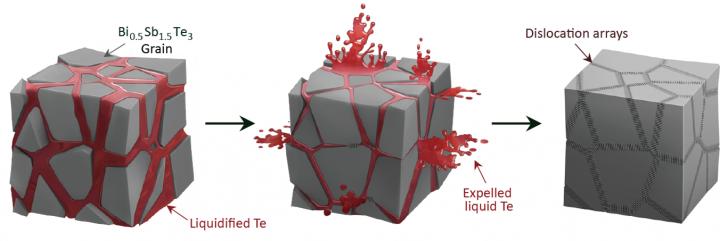A new breakthrough in thermoelectric materials

This schematic illustration shows the generation of dislocation arrays during the liquid-phase compaction process. The Te liquid (red) between the Bi0.5Sb1.5Te3 grains flows out during the compacting process and facilitates the formation of dislocation arrays embedded in low-energy grain boundaries. Credit: Institute for Basic Science
In the 1960's, Peltier devices were primarily made from Bismuth-Telluride (Bi2Te3) or Antimony-Telluride (Sb2Te3) alloys and had a peak efficiency (zT) of 1.1, meaning the electricity going in was only slightly less than the heat coming out. Since the 1960's there have been incremental advancements in alloy technology used in Peltier devices.
In 2014, researchers in South Korea at IBS Center for Integrated Nanostructure Physics along with Samsung Advanced Institute of Technology, the Department of Nano Applied Engineering at Kangwon National University, the Department of Energy Science at Sungkyunkwan University, and Materials Science department at California Institute of Technology California, USA have formulated a new method for creating a novel and much more efficient TE alloy.
TE alloys are special because the metals have an incredibly high melting point. Instead of melting the metals to fuse them, they are combined through a process called sintering which uses heat and/or pressure to join the small, metallic granules.
The joint team, including IBS researchers, used a process called liquid-flow assisted sintering which combined all three antimony, bismuth and telluride granules into one alloy (Bi0.5Sb1.5Te3). Additional melted tellurium was used as the liquid between the Bi0.5Sb1.5Te3 granules to help fuse them into a solid alloy, and excess Te is expelled in the process.
By creating the alloy this way, the joints between the fused grains, also known as the grain boundaries, took on a special property. Traditionally sintered Bi0.5Sb1.5Te3 have thick, coarse joints which have led to a decrease in both thermal and electrical conductivity. The new liquid-phase sintering creates grain boundaries which are organized and aligned in seams called dislocation arrays. These dislocation arrays greatly reduce their thermal conduction, leading to an enhancement of their thermoelectric conversion efficiency.
In tests, the efficiency (zT) reached 2.01 at 320 K within the range of 1.86 ±0.15 at 320 K (46.85° C) for 30 samples, nearly doubling the industry standard. When the melt spun Bi0.5Sb1.5Te3 alloy is used in a Peltier cooler, the results are also significant. The new material was able achieve a temperature change of 81 K at 300 K (26.85° C).
The applications for such a material are abundant. As new fabrication techniques are developed, Peltier cooling devices may be used in place of traditional compression refrigeration systems. More importantly, as electrical vehicles and personal electronic devices become more ubiquitous in our daily lives, it is becoming increasingly necessary to have more efficient systems for localized electrical power generation and effective cooling mechanisms. This new thermoelectric alloy paves the way for the future of modern TE devices.
Media Contact
All latest news from the category: Materials Sciences
Materials management deals with the research, development, manufacturing and processing of raw and industrial materials. Key aspects here are biological and medical issues, which play an increasingly important role in this field.
innovations-report offers in-depth articles related to the development and application of materials and the structure and properties of new materials.
Newest articles

Exploring Cell Death and Aging in Cancer Research
Latest findings on the significance and interaction between cell death and cellular senescence in cancer Aging cells secrete substances known to promote the growth of cancer cells. The development of…

Kenya Study Unveils Complexity of Tree-Planting Schemes
Research with smallholder farmers in Kenya shows that tree-planting schemes must account for complex local issues and preferences. Tree planting is central to many countries’ climate mitigation and biodiversity conservation…

Connecting Individual Cells to Plastic Electrodes: A Breakthrough
Researchers at Linköping University have succeeded in creating a close connection between individual cells and organic electronics. The study, published in Science Advances, lays the foundation for future treatment of…



